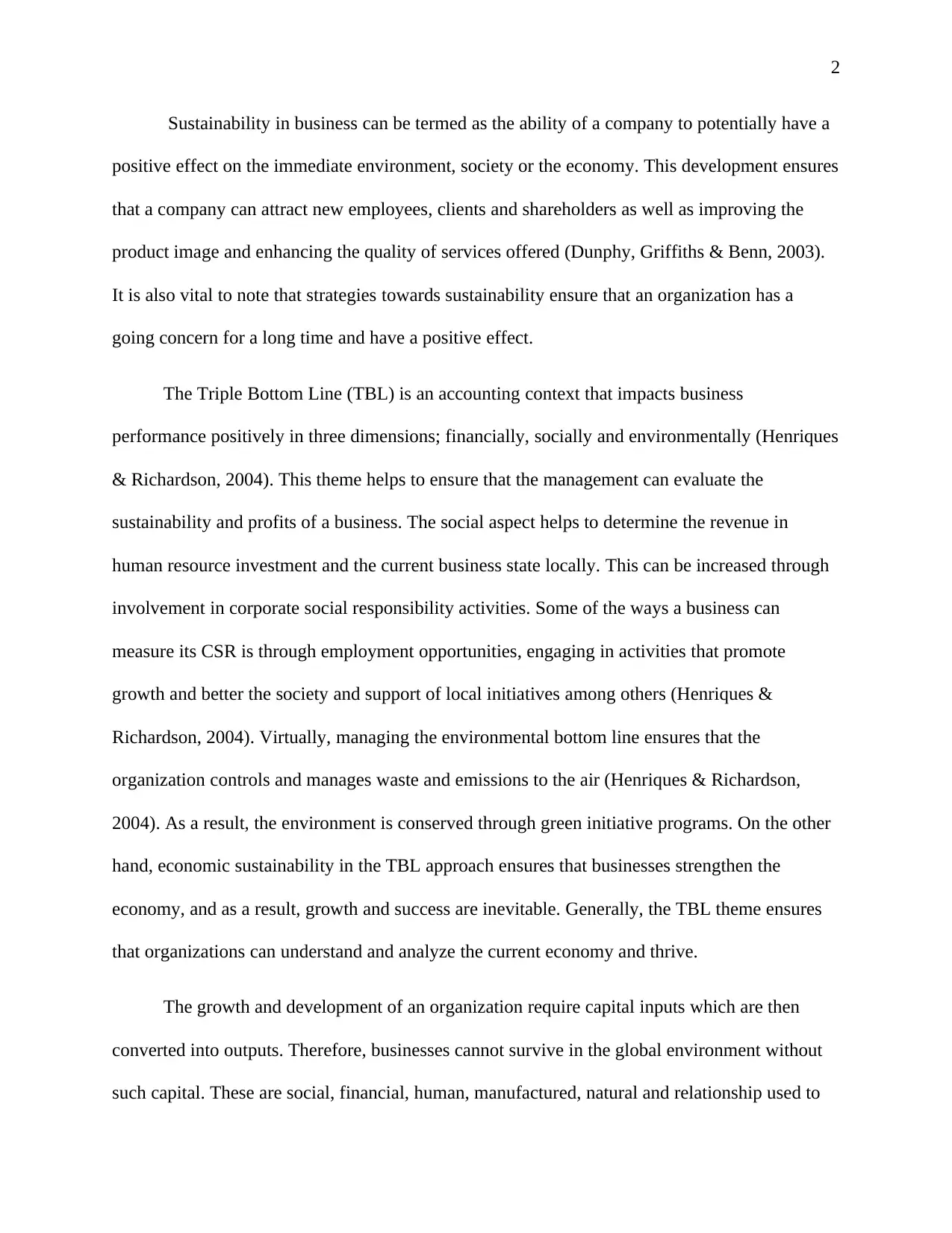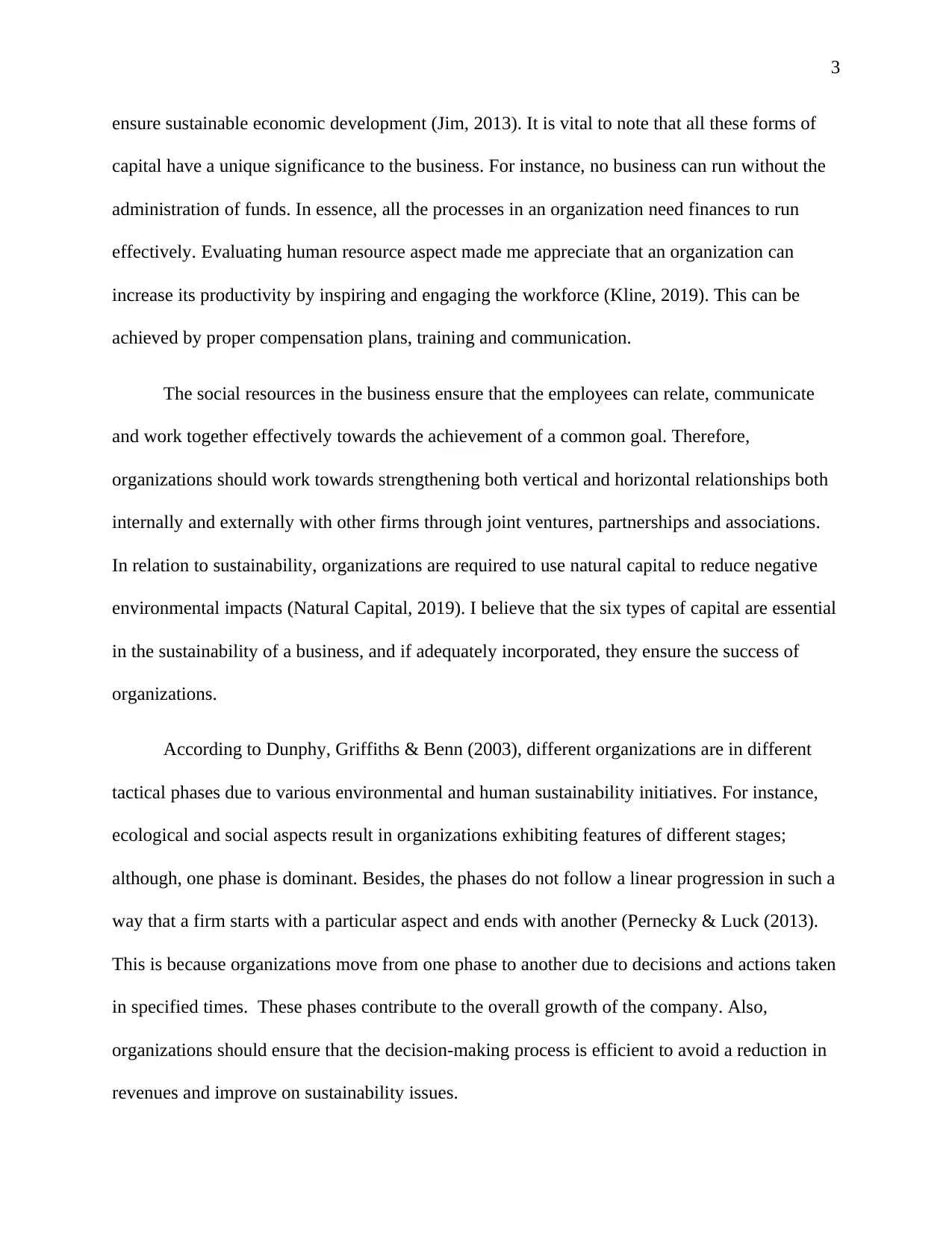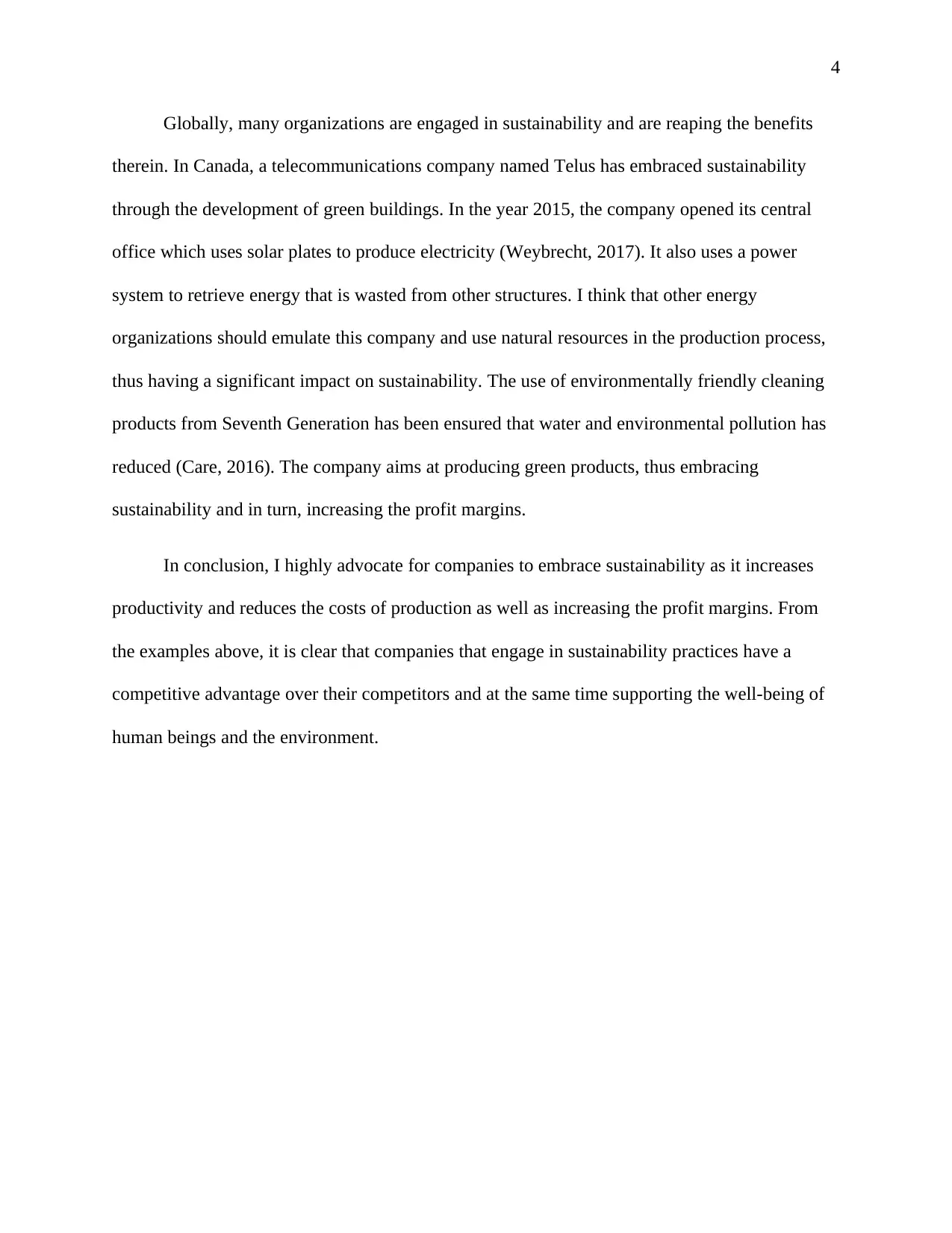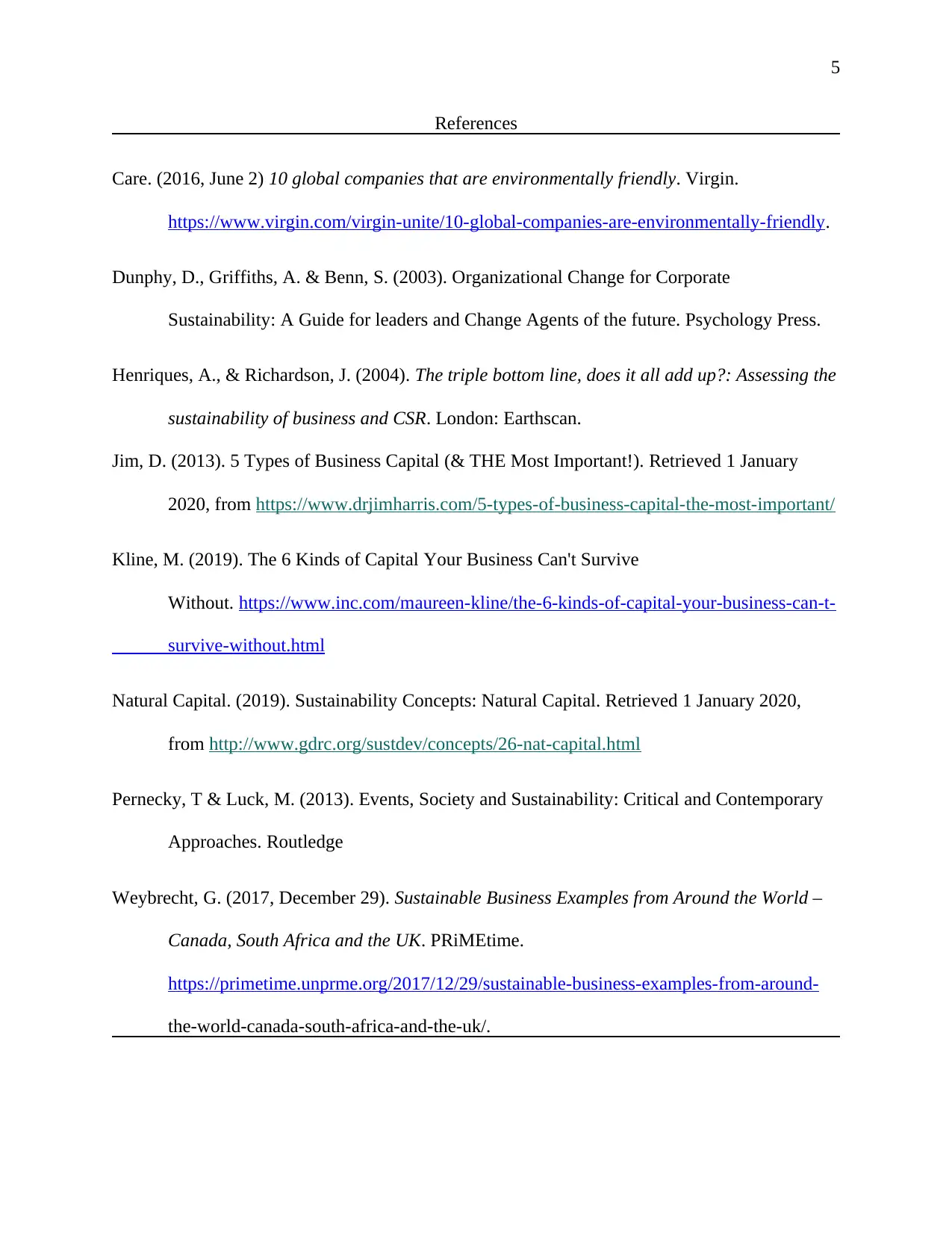Sustainable Business: Reflecting on Theory and Practice (BUGEN 5930)
VerifiedAdded on 2022/09/12
|5
|1146
|14
Journal and Reflective Writing
AI Summary
This reflective journal explores the concept of sustainability in business, emphasizing its positive impact on the environment, society, and the economy. It introduces the Triple Bottom Line (TBL) as a framework for evaluating business performance across financial, social, and environmental dimensions, highlighting the importance of corporate social responsibility, waste management, and economic growth. The journal further examines the six forms of capital—financial, social, human, manufactured, natural, and relationship—essential for sustainable economic development, emphasizing the role of human resource management, employee relations, and environmental impact reduction. It also discusses the phases of business approaches to sustainability and provides real-world examples of companies like Telus and Seventh Generation that have successfully integrated sustainability into their operations. The author advocates for companies to embrace sustainability, highlighting its potential to increase productivity, reduce costs, and enhance profit margins, ultimately providing a competitive advantage and contributing to the well-being of both humans and the environment.

1
Sustainable Business
Student Name
Institutional Affiliation
Course Name
Professor Name
Date
Sustainable Business
Student Name
Institutional Affiliation
Course Name
Professor Name
Date
Paraphrase This Document
Need a fresh take? Get an instant paraphrase of this document with our AI Paraphraser

2
Sustainability in business can be termed as the ability of a company to potentially have a
positive effect on the immediate environment, society or the economy. This development ensures
that a company can attract new employees, clients and shareholders as well as improving the
product image and enhancing the quality of services offered (Dunphy, Griffiths & Benn, 2003).
It is also vital to note that strategies towards sustainability ensure that an organization has a
going concern for a long time and have a positive effect.
The Triple Bottom Line (TBL) is an accounting context that impacts business
performance positively in three dimensions; financially, socially and environmentally (Henriques
& Richardson, 2004). This theme helps to ensure that the management can evaluate the
sustainability and profits of a business. The social aspect helps to determine the revenue in
human resource investment and the current business state locally. This can be increased through
involvement in corporate social responsibility activities. Some of the ways a business can
measure its CSR is through employment opportunities, engaging in activities that promote
growth and better the society and support of local initiatives among others (Henriques &
Richardson, 2004). Virtually, managing the environmental bottom line ensures that the
organization controls and manages waste and emissions to the air (Henriques & Richardson,
2004). As a result, the environment is conserved through green initiative programs. On the other
hand, economic sustainability in the TBL approach ensures that businesses strengthen the
economy, and as a result, growth and success are inevitable. Generally, the TBL theme ensures
that organizations can understand and analyze the current economy and thrive.
The growth and development of an organization require capital inputs which are then
converted into outputs. Therefore, businesses cannot survive in the global environment without
such capital. These are social, financial, human, manufactured, natural and relationship used to
Sustainability in business can be termed as the ability of a company to potentially have a
positive effect on the immediate environment, society or the economy. This development ensures
that a company can attract new employees, clients and shareholders as well as improving the
product image and enhancing the quality of services offered (Dunphy, Griffiths & Benn, 2003).
It is also vital to note that strategies towards sustainability ensure that an organization has a
going concern for a long time and have a positive effect.
The Triple Bottom Line (TBL) is an accounting context that impacts business
performance positively in three dimensions; financially, socially and environmentally (Henriques
& Richardson, 2004). This theme helps to ensure that the management can evaluate the
sustainability and profits of a business. The social aspect helps to determine the revenue in
human resource investment and the current business state locally. This can be increased through
involvement in corporate social responsibility activities. Some of the ways a business can
measure its CSR is through employment opportunities, engaging in activities that promote
growth and better the society and support of local initiatives among others (Henriques &
Richardson, 2004). Virtually, managing the environmental bottom line ensures that the
organization controls and manages waste and emissions to the air (Henriques & Richardson,
2004). As a result, the environment is conserved through green initiative programs. On the other
hand, economic sustainability in the TBL approach ensures that businesses strengthen the
economy, and as a result, growth and success are inevitable. Generally, the TBL theme ensures
that organizations can understand and analyze the current economy and thrive.
The growth and development of an organization require capital inputs which are then
converted into outputs. Therefore, businesses cannot survive in the global environment without
such capital. These are social, financial, human, manufactured, natural and relationship used to

3
ensure sustainable economic development (Jim, 2013). It is vital to note that all these forms of
capital have a unique significance to the business. For instance, no business can run without the
administration of funds. In essence, all the processes in an organization need finances to run
effectively. Evaluating human resource aspect made me appreciate that an organization can
increase its productivity by inspiring and engaging the workforce (Kline, 2019). This can be
achieved by proper compensation plans, training and communication.
The social resources in the business ensure that the employees can relate, communicate
and work together effectively towards the achievement of a common goal. Therefore,
organizations should work towards strengthening both vertical and horizontal relationships both
internally and externally with other firms through joint ventures, partnerships and associations.
In relation to sustainability, organizations are required to use natural capital to reduce negative
environmental impacts (Natural Capital, 2019). I believe that the six types of capital are essential
in the sustainability of a business, and if adequately incorporated, they ensure the success of
organizations.
According to Dunphy, Griffiths & Benn (2003), different organizations are in different
tactical phases due to various environmental and human sustainability initiatives. For instance,
ecological and social aspects result in organizations exhibiting features of different stages;
although, one phase is dominant. Besides, the phases do not follow a linear progression in such a
way that a firm starts with a particular aspect and ends with another (Pernecky & Luck (2013).
This is because organizations move from one phase to another due to decisions and actions taken
in specified times. These phases contribute to the overall growth of the company. Also,
organizations should ensure that the decision-making process is efficient to avoid a reduction in
revenues and improve on sustainability issues.
ensure sustainable economic development (Jim, 2013). It is vital to note that all these forms of
capital have a unique significance to the business. For instance, no business can run without the
administration of funds. In essence, all the processes in an organization need finances to run
effectively. Evaluating human resource aspect made me appreciate that an organization can
increase its productivity by inspiring and engaging the workforce (Kline, 2019). This can be
achieved by proper compensation plans, training and communication.
The social resources in the business ensure that the employees can relate, communicate
and work together effectively towards the achievement of a common goal. Therefore,
organizations should work towards strengthening both vertical and horizontal relationships both
internally and externally with other firms through joint ventures, partnerships and associations.
In relation to sustainability, organizations are required to use natural capital to reduce negative
environmental impacts (Natural Capital, 2019). I believe that the six types of capital are essential
in the sustainability of a business, and if adequately incorporated, they ensure the success of
organizations.
According to Dunphy, Griffiths & Benn (2003), different organizations are in different
tactical phases due to various environmental and human sustainability initiatives. For instance,
ecological and social aspects result in organizations exhibiting features of different stages;
although, one phase is dominant. Besides, the phases do not follow a linear progression in such a
way that a firm starts with a particular aspect and ends with another (Pernecky & Luck (2013).
This is because organizations move from one phase to another due to decisions and actions taken
in specified times. These phases contribute to the overall growth of the company. Also,
organizations should ensure that the decision-making process is efficient to avoid a reduction in
revenues and improve on sustainability issues.
⊘ This is a preview!⊘
Do you want full access?
Subscribe today to unlock all pages.

Trusted by 1+ million students worldwide

4
Globally, many organizations are engaged in sustainability and are reaping the benefits
therein. In Canada, a telecommunications company named Telus has embraced sustainability
through the development of green buildings. In the year 2015, the company opened its central
office which uses solar plates to produce electricity (Weybrecht, 2017). It also uses a power
system to retrieve energy that is wasted from other structures. I think that other energy
organizations should emulate this company and use natural resources in the production process,
thus having a significant impact on sustainability. The use of environmentally friendly cleaning
products from Seventh Generation has been ensured that water and environmental pollution has
reduced (Care, 2016). The company aims at producing green products, thus embracing
sustainability and in turn, increasing the profit margins.
In conclusion, I highly advocate for companies to embrace sustainability as it increases
productivity and reduces the costs of production as well as increasing the profit margins. From
the examples above, it is clear that companies that engage in sustainability practices have a
competitive advantage over their competitors and at the same time supporting the well-being of
human beings and the environment.
Globally, many organizations are engaged in sustainability and are reaping the benefits
therein. In Canada, a telecommunications company named Telus has embraced sustainability
through the development of green buildings. In the year 2015, the company opened its central
office which uses solar plates to produce electricity (Weybrecht, 2017). It also uses a power
system to retrieve energy that is wasted from other structures. I think that other energy
organizations should emulate this company and use natural resources in the production process,
thus having a significant impact on sustainability. The use of environmentally friendly cleaning
products from Seventh Generation has been ensured that water and environmental pollution has
reduced (Care, 2016). The company aims at producing green products, thus embracing
sustainability and in turn, increasing the profit margins.
In conclusion, I highly advocate for companies to embrace sustainability as it increases
productivity and reduces the costs of production as well as increasing the profit margins. From
the examples above, it is clear that companies that engage in sustainability practices have a
competitive advantage over their competitors and at the same time supporting the well-being of
human beings and the environment.
Paraphrase This Document
Need a fresh take? Get an instant paraphrase of this document with our AI Paraphraser

5
References
Care. (2016, June 2) 10 global companies that are environmentally friendly. Virgin.
https://www.virgin.com/virgin-unite/10-global-companies-are-environmentally-friendly.
Dunphy, D., Griffiths, A. & Benn, S. (2003). Organizational Change for Corporate
Sustainability: A Guide for leaders and Change Agents of the future. Psychology Press.
Henriques, A., & Richardson, J. (2004). The triple bottom line, does it all add up?: Assessing the
sustainability of business and CSR. London: Earthscan.
Jim, D. (2013). 5 Types of Business Capital (& THE Most Important!). Retrieved 1 January
2020, from https://www.drjimharris.com/5-types-of-business-capital-the-most-important/
Kline, M. (2019). The 6 Kinds of Capital Your Business Can't Survive
Without. https://www.inc.com/maureen-kline/the-6-kinds-of-capital-your-business-can-t-
survive-without.html
Natural Capital. (2019). Sustainability Concepts: Natural Capital. Retrieved 1 January 2020,
from http://www.gdrc.org/sustdev/concepts/26-nat-capital.html
Pernecky, T & Luck, M. (2013). Events, Society and Sustainability: Critical and Contemporary
Approaches. Routledge
Weybrecht, G. (2017, December 29). Sustainable Business Examples from Around the World –
Canada, South Africa and the UK. PRiMEtime.
https://primetime.unprme.org/2017/12/29/sustainable-business-examples-from-around-
the-world-canada-south-africa-and-the-uk/.
References
Care. (2016, June 2) 10 global companies that are environmentally friendly. Virgin.
https://www.virgin.com/virgin-unite/10-global-companies-are-environmentally-friendly.
Dunphy, D., Griffiths, A. & Benn, S. (2003). Organizational Change for Corporate
Sustainability: A Guide for leaders and Change Agents of the future. Psychology Press.
Henriques, A., & Richardson, J. (2004). The triple bottom line, does it all add up?: Assessing the
sustainability of business and CSR. London: Earthscan.
Jim, D. (2013). 5 Types of Business Capital (& THE Most Important!). Retrieved 1 January
2020, from https://www.drjimharris.com/5-types-of-business-capital-the-most-important/
Kline, M. (2019). The 6 Kinds of Capital Your Business Can't Survive
Without. https://www.inc.com/maureen-kline/the-6-kinds-of-capital-your-business-can-t-
survive-without.html
Natural Capital. (2019). Sustainability Concepts: Natural Capital. Retrieved 1 January 2020,
from http://www.gdrc.org/sustdev/concepts/26-nat-capital.html
Pernecky, T & Luck, M. (2013). Events, Society and Sustainability: Critical and Contemporary
Approaches. Routledge
Weybrecht, G. (2017, December 29). Sustainable Business Examples from Around the World –
Canada, South Africa and the UK. PRiMEtime.
https://primetime.unprme.org/2017/12/29/sustainable-business-examples-from-around-
the-world-canada-south-africa-and-the-uk/.
1 out of 5
Related Documents
Your All-in-One AI-Powered Toolkit for Academic Success.
+13062052269
info@desklib.com
Available 24*7 on WhatsApp / Email
![[object Object]](/_next/static/media/star-bottom.7253800d.svg)
Unlock your academic potential
Copyright © 2020–2025 A2Z Services. All Rights Reserved. Developed and managed by ZUCOL.





